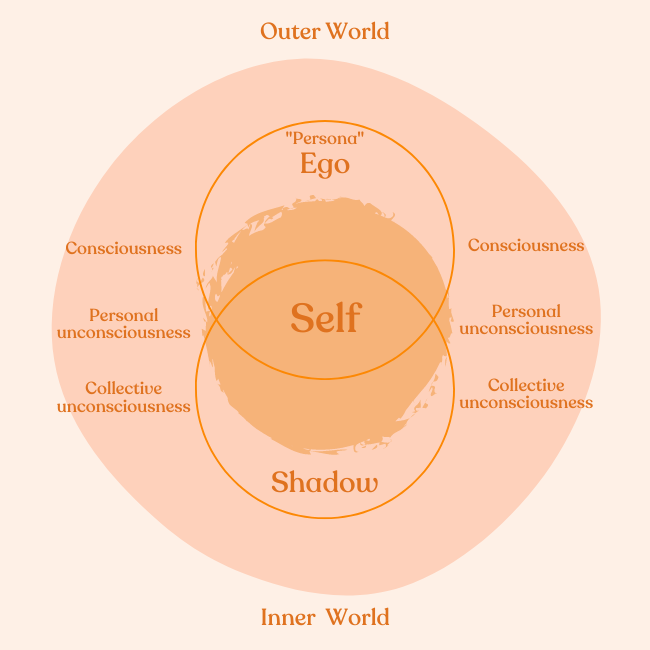HEALING & SELF IMPROVEMENT
Inner Flight Retreat
What is Shadow Work?
Our psyche holds a shadow self.
This shadow consists of aspects we’ve suppressed, hidden, or denied. These aspects are ones we don’t want others to see or even acknowledge ourselves.
Psychotherapy has a technique called “shadow work” that explores and addresses these hidden parts of the self.
The concept of “shadow self” was coined by Carl Jung. He recognized the tendency to avoid acknowledging traits that don’t fit our self-image.
Many strive to protect our self-image from anything perceived as negative or unfamiliar. Let’s explore deeper.
What is the Shadow?

Jung proposed that the human psyche is made up of several components, including consciousness, ego identity, and the shadow, which represents the unconscious mind.
Starting from birth, the mind takes in experiences, memories, traumas, and negative emotions – that the ego cannot process or find too overwhelming – and places them in the shadow.
This also includes societal taboos and aspects of ourselves that we have split off over time due to external influences or pressures.
Although these shadows may exist within us, we do not have to allow them to control us subconsciously.
Is the shadow side bad or evil?
The shadow side is not bad nor evil but unexplored and hidden from our conscious awareness. It remains in the darkness until we bring it into the light of our consciousness.
Some aspects of our shadow side may be considered “negative”, such as painful memories, shame, or fear, while others may be “positive”, like hidden talents or positive personality traits.
Shadow work is not about fixing ourselves but about accepting all parts of ourselves, including the ones we deem unacceptable. Consistently working with your shadow self is vital to achieving emotional and spiritual wholeness.

The shadow doesn't dissolve
Ignoring our shadow only allows it to grow and cause more harm in our lives. We must take the time to explore and confront our hidden parts to prevent them from festering and causing havoc.
“The shadow is not something to be feared, but rather an integral part of who we are. By facing our shadow and integrating it into our conscious awareness, we become more whole and authentic as human beings.” – Eckhart Tolle.
You're going into the shadow to free yourself
Shadow work is like taking a flashlight and embarking on an inner journey to explore the unknown parts of yourself.
It involves shedding light on the shadows holding you back or causing you pain. You don’t self-criticize but liberate yourself from excessive suffering and reveal your authentic self.
“Shadow work is a journey of self-discovery that leads to self-acceptance and inner peace.” – Carl Jung
As human beings, we can evolve and expand, not only in our physical form but also in our emotional and spiritual dimensions.
By bringing conscious awareness to our lives, we can move beyond living in a state of unawareness and experience life with more clarity and love. However, this transformation requires effort and dedication as we cultivate greater wholeness within ourselves and the world.
Shadow delving: The Path to Authenticity
After years of walking my inner work journey, I understand how much my shadow controlled me only now. As I study my interior landscape, I realize how interconnected everything is. Every experience we had as children, our experiences as adults, and even what we have experienced in past lives.
Awareness of my shadows has made me understand that “I am not broken or less good than others, but rather my “unfinished inner tasks” affect my present moment.
Every moment I manage to bring awareness to a part of myself that is painful to accept or see, it helps me discover more of who I am behind all the walls and masks I have built out of suffering as a coping mechanism. When I take a more profound step into my shadow, I take a deeper step into my authenticity.
“Embracing our shadow is a powerful step towards wholeness and authenticity.” – Debbie Ford
Shadow Work Steps
1. Recognize and acknowledge your shadow self
The first step is recognizing and acknowledging the parts of yourself that you try to hide or deny. This might involve identifying negative traits or behaviors you feel ashamed of or believe are unacceptable.
For example, you might recognize that you tend to be overly critical of yourself or others or struggle with addiction. It’s important to acknowledge these parts of yourself without judgment or shame, as this is the first step towards integrating them into your life.
2. Explore your triggers
Once you’ve identified your shadow self, it’s essential to pay attention to situations or people that trigger negative emotions or reactions in you. This can help you better to understand the underlying causes of your shadow self and work towards healing and integration.
For example, you might notice that you get angry or defensive when someone criticizes your work, which could be a sign of low self-esteem or a fear of failure.
3. Identify patterns
Journaling is a useful way to explore your subconscious through writing. By reflecting on your experiences, you can gain insight into your emotions and behaviors.
For example, you might analyze a recent argument with a friend to understand why it impacted you so strongly. You can also identify recurring patterns over time, which can help you recognize and address your shadow self.
4. Talk to yourself like you would talk to a friend
Shadow work can be a challenging and emotional process, so it’s important to be kind and gentle with yourself along the way. Remember that everyone has a shadow side, and it’s okay to make mistakes or have “negative traits”.
Practicing self-compassion can help you to approach your shadow self with acceptance and understanding rather than judgment or shame. For example, you might talk to yourself like you would talk to a friend struggling with similar issues.
5. Gain guidance
Working with a therapist, counselor, or coach trained in shadow work can be a helpful way to navigate your emotions and gain guidance as you explore your shadow self.
A trained professional can provide a safe and supportive environment to explore your shadow self and help you develop strategies for healing and integration. For example, you might work with a therapist to explore your childhood experiences and how they have shaped your current behavior patterns.
6. Take action
Once you’ve identified your shadow self and worked to understand it, it’s important to integrate those parts of yourself into your life healthily. This might involve setting boundaries, practicing self-care, or working to change negative patterns or behaviors.
For example, if you recognize that you tend to be overly critical of yourself, you might start practicing self-compassion by taking time to do things that make you feel good, like walking or reading a book.
Over time, taking action to integrate your shadow self can lead to greater self-awareness, self-acceptance, and personal growth.
Shadow Work and Plant Medicine
Shadow work is also an indispensable tool when working with plant medicine. If you plan to work with plant medicine, shadow work is what you need to do as preparation and also for integration work.
If you feel ready to take the next step towards personal development and consciousness, join our plant medicine retreat in Costa Rica. Authentic shamans from the Shipibo Peru tradition facilitate it.
If you enjoyed this edition of The Inner Flight Letter, consider sharing it with a friend.




